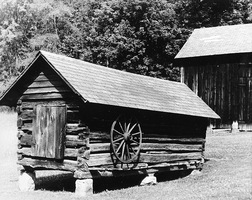
Corncribs, a common feature of the West Virginia landscape since early times, provide rodent-proof storage for field corn. Traditionally, corn was left to dry in tall shocks in the field until November, then hauled to the corncrib. Husking bees brought neighbors together to get the corn crop ready for storage. The best ears were put aside for corn meal or saved for seed.
The first cribs in Western Virginia date to the mid-1700s, soon after settlers arrived. Early cribs were simple log structures with either a shed roof or gabled roof. An overhang on one end of the gable to shelter the doorway was common in present southern West Virginia. Log cribs in the north and in the present Eastern Panhandle were often constructed in a V-shaped design, with the side walls slanting inward so that the floor area was smaller than the area under roof.
The floor of the corncrib was elevated above ground on stone pillars to discourage rodents and to facilitate air circulation. Spacing between the logs provided interior ventilation. During the 19th century, sawed lumber replaced logs in the construction of cribs, which were sided with slats with regularly spaced gaps between. Early crib roofs were usually made of split-wood shingles, later replaced by tin roofing or asphalt shingles.
A common design featured dual cribs under a single roof, with a passage through the center that allowed a wagon sheltered access to the cribs on both sides. Other cribs were attached to barns as a lean-to addition. Often the Appalachian corncrib shared space with a granary. Corncrib designs by the early 20th century included a thinner and taller rectangular structure that enabled the corn to dry more quickly.
Traditional farmers raising cattle and hogs depended on the well-built corncrib. Dairy and beef cattle remain an important part of the state’s agriculture, and most producers now use cylindrical, steel-mesh corncribs with a conical roof. Among small farmers in West Virginia many wooden corncribs are still in use.
This Article was written by Scot E. Long
Last Revised on November 10, 2023
Related Articles
Sources
News from the Frontier Culture Museum vol. 17. Staunton, VA: 2002.
Schultz, LeRoy G. West Virginia Cribs and Granaries. Goldenseal, (Winter 1983).
Cite This Article
Long, Scot E. "Corncribs." e-WV: The West Virginia Encyclopedia. 10 November 2023. Web. 22 October 2024.


Comments?
There aren't any comments for this article yet.
Click here to read and contribute to the discussion →